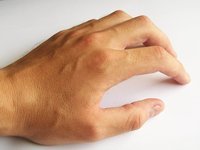THE SKIN (I)
THE SKIN
The skin is the outer covering of the body of a living animal.

In human, it is part of the integumentary system. It is the fastest growing and largest organ of the body.
There are two types of skins
- Hairy
- Glabrous (hairless)
The skin has three (3) layers, namely:
Epidermis : the outermost layer which serves as a water proof barrier and contains the colour determining factor of the skin.
Dermis : the layer beneath the epidermis that contains tough connective tissues, hair follicles, nerve cells and sweat glands.
Hypodermis : made of fat and connective tissues.
The skin also has glands which are very crucial to the skin. There are 3 types of glands on the skin.
• Eccrine gland which secretes sweat through pores found in the palms of the hands and soles of the feet and forehead.
• Sebaceous glands which secrete oily sebum and are found on the chest, back, scalp, face and forehead.
• Apocrine glands which secrete sweat via canals along the hair follicles in the underarm, pubic area, anus and nipple area.
Components of the skin and their functions
• Melanin – It determines the colour of the skin. It is a pigment secreted by special cells called melanocytes which are located in the epidermis.
• Sebaceous glands – usually open to the hair follicles on the surface of the skin. The produce the oily secretion sebum which is mostly concentrated on the face and scalp region, the most oily area of the skin.
• Hairs – grows from hair follicles. They keep the body warm by trapping air underneath them. There are no hairs on the palm of hands and sole of the feet.
• Blood vessels – they dilate in response to heat and constrict in response to cold to keep the body in a constant temperature.
• Collagen – it the most abundant protein in the skin making up 75 percent of the skin. This protein wards off wrinkles and fine lines indicating youthfulness. Overtime, the body ability to produce this protein diminishes showing ageing.
• Elastin – gives structure to the skin. This protein just like collagen when diminished causes the skin to sag and wrinkle.
• Keratin – it is the strongest form of protein in the body. It holds the skin cells together and form the outermost layer of the skin that protect the body from the environment.
General functions of the skin
The skin has three main functions:
Protection, Regulation and Sensation
• The skin provides protection from mechanical impacts and pressures, variation in temperature, microorganisms, radiations and harmful chemicals.
• The skin regulates the body temperature through sweat and hair.
• The skin serves as an organ of sensations with separate receptors for heat, cold, touch and pain including vibration.
• The skin also serve as a storage for water and lipids including for the synthesis vitamin D
Skin diseases
The skin has shown to have different infections or diseases caused by viruses, bacteria, fungi and mechanical or environmental factors.
DERMA is the greek word used for skin. The branch of medicine that deals with the study of skin and its diseases is called DERMATOLOGY.
Doctors who are experts in caring for the skin are called Dermatologists.
Some of the common infections that occur on the skin include:
*Rash * Eczema * Dandruff * Acne * Warts * Dermatitis * Keratosis * Ring Worm * Scabies * Shingles * Melanoma
Care of the skin
- Always keep the skin clean, soft and moisturized especially the scalp.
- Eat well-balanced diet.
- Drink enough water.
- Bathe at least twice daily with mild soap.
- Protect the skin from the sun.
- Avoid bleaching, tattoos and scars that can affect the normal functioning of the skin.
- Avoid smoking.
REFERENCES:
- https://en.m.wikipedia.org/wiki/Human_skin
- http://www.webmd.com/skin-problems-and-treatments/picture-of-the-skin
- http://www.m.webmd.boots.com/a-to-z-guides/picture-of-the-skin
- https://www.ncbi.nlm.nih.gov/pubmedhealth/PMHT0022679/
- https://www.aad.org/public/kids/skin
- http://science.nationalgeographic.com/science/health-and-human-body/human-body/skin-article/
- https://www.sharecare.com/health/healthy-skin/different-types-glands-on-skin
- http://www.clinimed.co.uk/Wound-Care/Education/Wound-Essentials/Structure-and-Function-of-the-Skin.aspx
- freeimages.com
I’m a Microbiology undergraduate at the University and I’m fascinated with learning amazing stuff about life everyday.
Steemit is rekindling my love for research and writing and I will be sharing with you amazing stuff I discover everyday at school and over the course of my search for knowledge.
wow thanks
You are welcome.
SKIN II would be based on skin diseases or conditions and their treatment
thanks